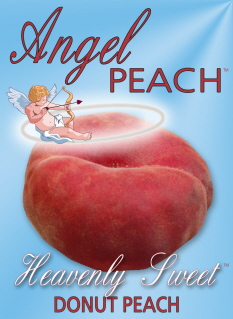 Angel Peach - Heavenly Sweet
Angel Peach - Heavenly Sweet
Donut Peach
The Angel Peach is a new plant release, due out in winter 2008, from PlantNet®.
The Angel Peach is the second, new and exciting plant release from PlantNet after Pinkabelle, the Dwarf Pink Lady™ Apple tree.
The Angel Peach is a new form of peach, which has donut shaped fruit. This Angel Peach is most noted for its unusual shape. It is a sweet white fleshed variety, which appears to be more soft and juicy in texture compared with standard peaches and is low in acid and high in sugar. It contains a small "freestone", also known as a "slipstone" peach. The Angel Peach grows to approximately 3 metres by 3 metres, and displays a beautiful spring flush of pink flowers. PlantNet has two varieties of the Angel Peach which can be grown around Australia - a high chill variety, which fruits in January / February, for the cooler areas and a low chill variety, which fruits in December, for the warmer areas of Australia. The Angel Peach is 100% self fertile which means it will set fruit without any other peach varieties being present in your garden or neighbourhood. Donut shaped peaches originated in China, and were particularly sought after by the Chinese Emperors as they could pop the whole fruit in their mouth, eat all of the flesh and then spit out the small seed, all without spilling juice in their long flowing beards! The Angel Peach, which is donut shaped with rounded sides that draw in toward an indented centre, like a donut without a hole, is a descendant of the original Chinese peach. PlantNet is proud to invite all home gardeners to grow their own donut shaped peaches!
History of the Peach
• The peach originated in China and has been cultivated at least since 1,000 B.C. It has special significance in Chinese culture: the peach tree is considered to be the tree of life, and peaches are symbols of immortality and unity. Peach blossoms are carried by Chinese brides.
• Peaches travelled west via the silk roads to Persia, earning them the botanical name Prunus persica. In Persia peaches were discovered by Alexander the Great, who mentions half a dozen types, and who introduced them to the Greeks
• By 322 B.C. Greece enjoyed the peach and by 50 to 20 B.C., Romans grew and sold them for the modern equivalent of $4.50. The Romans called the peach a Persian apple, and the name for peach in numerous languages is the name for Persia. Once the Romans cultivated the fruit, they were able to transport it north and west to other countries of their European empire.
• The peach has many different names depending on which country you are in: pêche (French), Pfirsich (German), pesca (Italian), melocotón (Spanish), pêssego (Portuguese), fersken (Danish/Norwegian), persika (Swedish), persikka (Finnish), persik (Russian), brzoskwinia (Polish), breskva (Serbo-Croat), piersica (Romanian), praskova (Bulgarian), robakinon (Greek), seftali (Turkish), afarseq (Hebrew), khúkh (Arabic), hulu (Persian), arú (Hindi), tao (Chinese), momo (Japanese), persik (Indonesian)
• To this day China remains the largest world producer of peaches, with Italy second. Italy is the main exporter of peaches in the European Union (EU); the regions of Campania and Emilia Romagna account for more than 50% of Italy's annual production. California produces over 50% of the peaches in the United States (and grows 175 different varieties). So many peaches are grown in Georgia that it became known as the Peach State.
• True wild peaches are only found in China. Unlike the cultivated fruit, the wild fruit is small, sour and very fuzzy.
Nutrition and Factoids
• Peaches are a good source of vitamins A, B and C. A medium peach contains only 37 calories.
• You can ripen peaches by placing them in a brown paper bag for 2-3 days. Sliced, fresh peaches should be tossed in lemon or lime juice to prevent browning. Some varieties are non-browning.
• Nectarines are just a 'fuzzless' peach with a smooth skin, not a cross between a peach and a plum, which is an urban myth.
• The juice from peaches makes a wonderful moisturiser and it can be found in many brands of cosmetics.
• A peach seed contains hydrocyanic acid (similar to cyanide), which is a poisonous substance.
• Like the plum, cherry and the apricot, the peach is a member of the rose family (Rosaceae), distinguished by its velvety skin. It is classified as a drupe, a fruit with a hard stone.
• Peaches are a favourite fresh snacking fruit and cereal fruit, and make wonderful pies and jams.
• Peach ice cream is a summer favourite.
• Ripe peaches freeze well for later use. Famous Peach Dishes
• The Bellini: fresh peach purée and spumante, which is Italian sparkling wine, (Champagne or other sparkling wine can be used). The drink is said to have originated in the 1930s at Harry's Bar in Venice, a favourite haunt of Ernest Hemingway, and named for the famed Italian opera composer.
• Peach Melba: poached peaches, vanilla ice cream and raspberry purée. The dessert is named after Nellie Melba, the great Australian operatic soprano.





